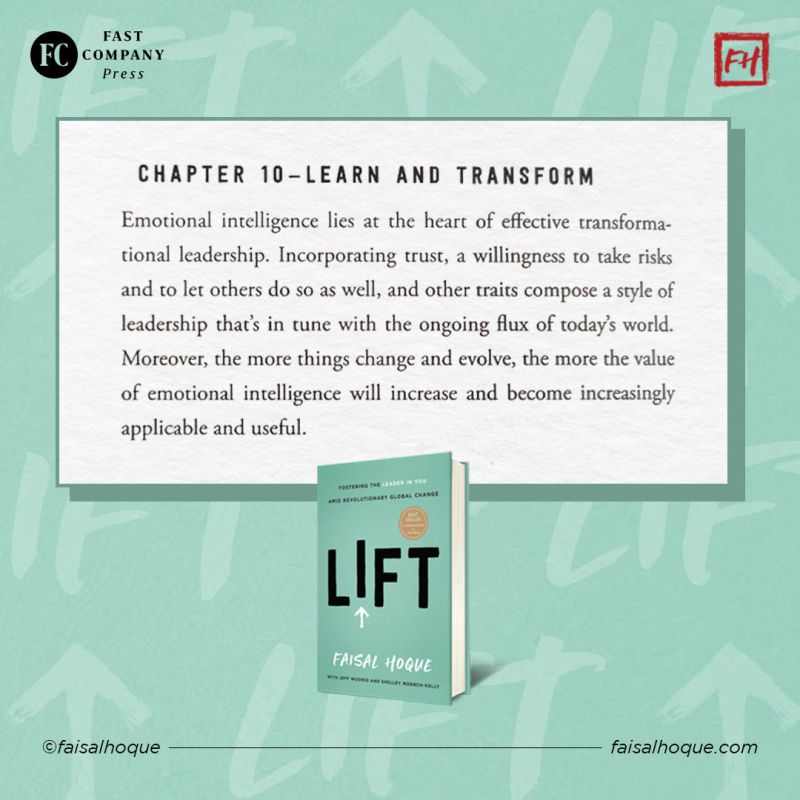Empathy is the cornerstone of transformational leadership
Emotional intelligence without a thoughtful, orchestrated strategy is like a Ferrari without a single drop of gas—powerful only in theory.
[This article is adapted from the #1 Wall Street Journal and USA Today best selling book LIFT by Faisal Hoque.]
When asked to name the most important components of transformation and reinvention, many leaders would naturally defer to the usual suspects, such as training, the right technology, adequate funding and other necessities. All those are worthy answers. But what’s often overlooked is emotional intelligence, coupled with systemic execution of ideas and strategies that can spring from that mindset.
Emotional intelligence can be described as the capacity to be keenly aware of your own emotions and the impact they can have on any sort of personal or professional relationship.
First coined by researchers at Yale University in the 1990s, emotional intelligence actively engages emotions in decision making, problem solving and other areas—both your emotions as well as others.
That sort of empathy is a cornerstone of transformational leadership—and a cornerstone of the leaders that we can all strive to become. So many of the attributes of transformational leadership can be ascribed to this sense of value that emotional intelligence places on how we interact with others.
Other attributes include:
- A willingness to accept uncertainty. An emotionally intelligent individual recognizes that the world is a volatile place—perhaps now so more than ever. Accordingly, transformational leadership encourages flexibility, creativity and approaches that are more adaptive to uncertainty.
- Trustworthiness. As South African researcher Dr. Eben Haeser Swanepoel puts it: “The use of smart systems and AI in workspaces necessitates collective input to sustain overall employee morale and workplace well-being. Leaders are continuously challenged to exhibit skillsets that involve mindfully sharing information to inspire employees, while also being challenged to re-evaluate the self and self-knowledge to successfully steer the organization through the effects of internal and external sources of disruption.”
- A willingness to learn. Emotional intelligence isn’t necessarily something that we’re all born with. By approaching the task thoughtfully and systematically, we can all develop the skills and attributes of effective transformative leadership and emotional empathy. To further the effort, try to surround yourself with others who display emotional smarts. We can all certainly learning from one another.
 These and more like them are certainly worthy attributes worth pursuing. But, without the ability to put them into practice in an effective manner, they can remain wonderful but every bit as inapplicable. That’s where systemic execution comes into play.
These and more like them are certainly worthy attributes worth pursuing. But, without the ability to put them into practice in an effective manner, they can remain wonderful but every bit as inapplicable. That’s where systemic execution comes into play.
It’s critical to connect the emotional intelligence inherent in transformational leadership to systematic thinking and action—a pragmatic, disciplined approach to planning and execution that embodies (and delivers) the principles of transformational leadership. That convergence of our emotional selves with an actionable methodology offers the best opportunity to leverage change to build long term value, not merely short term answers with little or no lasting relevance.
Putting emotional intelligence into an effective operational mode begins with asking questions:
- Is what we (or I) doing now really working? Is the current strategy effective and, if so, is its execution the best it can be?
- Will what we do today have long term ramifications for the future?
- Do I have what I need to help ensure a successful change or shift? Change may be inevitable, but it’s never prudent to rush into anything without considering your resources.
- Are we getting the most out of what information we can access? One of the biggest challenges to reinvention is a tsunami of information—with so much to sort through, is truly valuable information and data slipping through the cracks?
- Are we charting change? Reinvention requires context. It’s always helpful to know the detailed course of how you got from one place to the next.
But it’s more than just asking the right sorts of questions. Here are some additional tips:
- Focus on purpose and outcomes, not activities. Don’t micromanage.
- Collaborate, don’t compete. Transformational leaders embrace collaboration. Once again, it’s the outcome that matters, not just the last one standing.
- Don’t make solutions and “winning” inseparable. Effective outcomes shouldn’t have to involve someone or something “losing.” Look to results and how people contributed, rather than accepting that someone or something has to somehow come out on the short end of things. Focus on group success.
- Develop both the flexibility and capacity to pivot quickly. Be ready and willing to adjust when necessary. To adapt quickly, pay attention to small things. Sometimes, when seemingly insignificant or innocent things occur, it can be all too tempting to dismiss them as outliers. An emotionally intelligent, transformational leader isn’t so quick to ignore what might prove important.
- Know what to say as well as what not to say. Unlike their more transactionally minded colleagues, transformational leaders need to be aware of the consequences and implications of what they say to others, even in what seem to be innocent conversations.
- Finally, be an exponential leader. It seems clear that an effective transformational leader will have to wear many hats, some of which he or she may never have even dreamed of trying on. But that’s really no different from so much of the change and disruption we’ve experienced and will continue to witness—new ways of thinking, new skills and new approaches. That in turn argues for the value of a transformational leader who is also an exponential leader—one who is willing to acquire and apply a variety of different skills and approaches.
Emotional intelligence without a thoughtful, orchestrated strategy with which to express that valuable form of leadership is like a Ferrari without a single drop of gas—powerful only in theory. Combine the two, however, and the speed with which great things can happen is truly breathtaking.
© 2022 by Faisal Hoque. All rights reserved.















